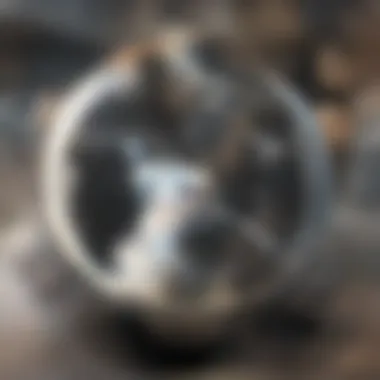Effective Techniques for Cleaning Your TV Screen


Intro
In today's digital age, televisions have become integral to daily life, serving as a primary source of entertainment, information, and even relaxation. Their screens are intricate devices that require diligent care and cleaning to maintain optimal performance and durability. The necessity of understanding the right methods and materials for cleaning various types of TV screens cannot be overstated. This article aims to provide comprehensive guidance on techniques suitable for different types of screens: LCD, OLED, and Plasma.
Cleaning a TV screen might seem straightforward, yet specific techniques can prevent irreversible damage or diminished performance. Furthermore, the right tools and materials are crucial in avoiding streaks, scratches, or display issues. This guide is designed to equip the reader with essential knowledge and practical approaches to ensure that televisions remain in prime condition.
By delving into the specific characteristics of screen types, this article addresses common missteps and misconceptions regarding TV cleaning. The subsequent sections will outline recommended tools, cleaning solutions, and proper methods for maintaining and enhancing screen life while ensuring optimal viewing experience.
Understanding TV Screen Types
Understanding the different types of TV screens is crucial for proper cleaning and maintenance. Each screen technology has unique characteristics that affect how it reacts to cleaning methods and materials. Knowing whether you have an LCD, OLED, or Plasma screen sets the groundwork for selecting appropriate cleaning tools and techniques. This knowledge helps avoid damage and ensures that your TV continues to provide optimal picture quality.
Screens
LCD, or Liquid Crystal Display, screens have been widely used in televisions for many years. They use liquid crystals sandwiched between two layers of glass or plastic. One of the main benefits of LCD screens is their brightness and ability to display rich colors. When cleaning an LCD screen, it is essential to use materials that won't scratch their surface. A microfiber cloth is recommended for this purpose, as it effectively removes dust and fingerprints without causing any harm.
For cleaning solutions, a mixture of distilled water and a small amount of vinegar can be effective. Avoid using any cleaners that contain alcohol or ammonia, as these can damage the screen coating over time. Regular cleaning not only enhances the screen's appearance but also prolongs its life.
OLED Screens
OLED stands for Organic Light Emitting Diode. This technology allows each pixel to emit its own light, which leads to deeper blacks and a broader color spectrum. OLED screens are known for their impressive contrast ratios and viewing angles. However, they require gentle handling during cleaning because they are more sensitive to harsh chemicals.
Using a damp microfiber cloth is beneficial for wiping down the screen. For tougher spots, you might mix distilled water with a few drops of mild soap. Never spray liquid directly onto the screen—always apply it to the cloth first. Proper care helps maintain the screen's exceptional quality and reduces the risks of burn-in effects, which can occur with prolonged use of static images.
Plasma Screens
Plasma screens utilize small cells filled with ionized gas to produce images. They are celebrated for their excellent color accuracy and wide viewing angles. However, like OLED, plasma screens can be quite delicate. When cleaning, a soft cloth, preferably microfiber, should be used to prevent scratches.
For cleaning solutions, a gentle soap and water mixture can be used. It is crucial to ensure that no liquid seeps into the edges of the panel, as this can cause internal damage. Regular gentle cleaning will help keep the plasma screen looking vibrant.
In summary, comprehending the differences between LCD, OLED, and Plasma screens influences the cleaning methods you should use. This knowledge protects your investment and enhances the viewing experience.
Importance of Regular Cleaning
Cleaning your TV is more than just a cosmetic task; it plays a crucial role in maintaining performance and ensuring longevity. Regular cleaning can prevent many common issues that might arise from neglect, including deterioration in image quality, dust build-up, and potential hardware malfunctions.
Preventing Dust Accumulation
Dust accumulation on a TV screen is not just unsightly; it can also affect how the television operates. Dust particles can interfere with the screen's ability to display colors accurately. When dust settles on the display, it absorbs and reflects light. This can create a hazy appearance, which diminishes the visual experience. Moreover, an accumulation of dust around electronic components can lead to overheating, which shortens the lifespan of your device.
To minimize dust build-up, conduct regular cleaning routines. A weekly dusting of the TV frame and screen with a microfiber cloth can significantly reduce accumulated dust. Keeping the area around the TV clean also contributes to maintaining a dust-free environment.
Maintaining Picture Quality
A clean screen is essential for preserving picture quality. Dust and smudges can obscure the image, resulting in a less vibrant viewing experience. Regular cleaning ensures that the colors remain true to the original content and that clarity is not compromised. This is particularly important for high-definition screens, where every detail counts.
Using proper materials and methods helps maintain the screen's integrity. Avoiding harsh chemicals ensures that the display remains scratch-free and shows no signs of wear over time. It is advisable to use solutions designed specifically for screen cleaning in conjunction with soft materials that won’t damage the surface.
Extending TV Life Span


Regular maintenance through cleaning can significantly extend the lifespan of your television. Dust and debris can lead to overheating of internal components, which may cause premature failure. By keeping the TV clean, you facilitate better air circulation around the electrical components.
In addition to the external surfaces, it is beneficial to clean the remote control and any additional components regularly. These items are often overlooked but significantly contribute to overall functionality. Avoiding the use of harsh or inappropriate cleaners also reduces the risk of damage. Using gentle cleaners helps to preserve screens and ensure that they last longer without the need for replacements.
"Consistency in cleaning not only enhances the viewing experience but also saves money in the long run by preventing damage."
Recommended Cleaning Tools
Cleaning your TV requires specific tools that help maintain the screen's clarity and physical integrity. Using the appropriate cleaning tools can prevent damage that might occur from using unsuitable items. Choosing the right tools not only ensures the cleaning job is effective but also protects your investment by extending the lifespan of your television.
Microfiber Cloths
Microfiber cloths are essential when it comes to cleaning screens. They are designed to lift dust and dirt without scratching the surface. Because of their gentle texture, they will not leave behind streaks or lint. When you use a microfiber cloth, you reduce the risk of damaging sensitive screen technology.
Microfiber also absorbs moisture effectively, which helps in minimizing water damage when cleaning. This material is versatile and can be washed and reused, making it a sustainable choice for cleaning your TV. When purchasing, ensure the cloth is labeled as safe for screen use to avoid any unwanted effects.
Screen Cleaners
Screen cleaners are available in various types, and choosing the right one is crucial for effective cleaning.
Types of Solutions
There are typically two main types of screen cleaning solutions: liquid solutions and pre-moistened wipes. Liquid solutions are usually preferred for deep cleaning because they allow for better control over the amount applied. This control is important to prevent dripping that could lead to moisture damage. The best screen cleaning solutions are alcohol and ammonia-free, as these chemicals can damage the screen’s coating.
Pre-moistened wipes are convenient and ready to use but may not always be ideal for larger screens, depending on their moisture retention.
Commercial vs. Homemade
When deciding between commercial cleaners and homemade solutions, consider efficacy and safety. Commercial cleaners are formulated for screen care and may contain additives that enhance cleaning power. They often come with specific instructions on usage, but this also means an additional cost.
Homemade solutions, like a mixture of water and vinegar, can be effective and cost-efficient. They are generally safer for the environment as well. However, it is crucial to ensure that any homemade solution does not include harmful ingredients that could potentially strip the finish of your screen.
Compressed Air Canisters
Compressed air canisters are a practical choice for cleaning TV components like vents and spaces where dust collects. Using compressed air helps dislodge particles without leaving residue or damaging delicate components. Aim the nozzle carefully to avoid blowing dust deeper into the device. Additionally, using compressed air can prevent dust buildup, promoting better ventilation and cooling, which is essential for the safe operation of your TV.
Proper care with these tools will help maintain the visual quality of your TV while also ensuring its longevity. Each of these cleaning tools serves a unique purpose and can lead to a cleaner and more enjoyable viewing experience.
DIY Cleaning Solutions
Cleaning your TV does not always require expensive commercial products. DIY cleaning solutions can be effective and economical. The topic of DIY solutions is central to this article because it empowers consumers to use safe, readily available materials. This approach not only saves money but also reduces the risk of damaging delicate screens with harsh chemicals. Choosing suitable DIY solutions involves understanding their composition and ensuring they are safe for specific screen types, like LCD, OLED, or Plasma.
Vinegar and Water Mixture
The vinegar and water mixture is a simple yet potent cleaning solution. It is particularly useful for cutting through grime and fingerprints. This solution is effective because vinegar possesses natural cleaning properties. To create this mixture, combine equal parts of distilled white vinegar and water in a clean spray bottle. It is essential to use distilled water since tap water can leave mineral spots and residues.
To apply this solution, lightly spray a microfiber cloth with the mix. Wipe the screen gently in circular motions. Avoid spraying directly onto the screen to prevent moisture from seeping into the device. This method not only cleans but also aids in maintaining screen clarity without risking damage. Vinegar's acidic nature proves effective in breaking down tough stains without the use of toxic chemicals.
Distilled Water Options


Using distilled water is another excellent option for cleaning TV screens. Distilled water has undergone a purification process, which means it is free from impurities and minerals that can leave marks. It is an ideal choice when combined with a soft, lint-free cloth.
For optimal results, dampen a microfiber cloth with distilled water and wipe down the screen. This method ensures you're not introducing any harmful substances to the screen surface. Moreover, distilled water can also be used as a base for other DIY solutions, enhancing their effectiveness.
Commercial Screen Cleaner Alternatives
While DIY solutions are great, sometimes commercial screen cleaners are necessary. They are specifically formulated for electronic screens and usually include anti-static properties. Commercial options like screen cleaner sprays from brands such as 3M and EcoGreen offer convenience. They often come with instructions tailored for specific screens, which is a significant advantage for users.
When considering these products, check ingredients carefully. Avoid those containing alcohol or ammonia, as these substances can harm screen coatings. Furthermore, choose products designed for the type of screen you own to ensure compatibility. These commercial alternatives provide a balance between ease of use and effectiveness, complementing DIY methods for comprehensive maintenance.
Safe Cleaning Techniques
Cleaning your television can be a delicate process. Utilizing safe cleaning techniques is imperative to maintain the integrity of your device. Here, we outline several best practices that not only protect your TV but also improve its longevity and picture quality. A careful approach minimizes the risk of damage from improper cleaning methods, which could lead to costly repairs or replacements.
Turn Off the TV
Before beginning any cleaning, it is crucial to turn off your TV. This step serves multiple purposes. First, powering down allows you to see smudges and dust more clearly against a dark screen. Additionally, it reduces the risk of electrical issues and overheating. Some screens may be sensitive to moisture, and cleaning a powered-on device can create electric shocks or cause pixels to malfunction. Always ensure that the device is unplugged for a few minutes to cool down before you start.
Gentle Wiping Motions
The manner in which you wipe your TV screen is significant for effective cleaning. Avoid applying excessive pressure when using a cloth. Instead, employ gentle, circular motions. This technique helps lift debris without scratching the screen. Microfiber cloths are ideal in this scenario, as they are designed to trap dirt and dust particles effectively. Unlike paper towels, microfiber materials are soft and significantly reduce the risk of leaving marks or scratches on the TV surface.
Avoiding Excessive Moisture
Moisture is a double-edged sword in cleaning electronics. While a slightly damp cloth can assist in removing stubborn stains, excessive moisture can seep into the internal components of the TV. This can lead to corrosion or short circuits. To minimize risk, always ensure that your cleaning solution is either applied to the cloth first or is a non-abrasive spray specifically designed for screens. A damp cloth should not drip water. If any moisture does accumulate, dry the screen immediately to prevent damage.
Maintaining these safe cleaning techniques not just ensures the device remains functional but also uphold the quality of the viewing experience.
Addressing Common Cleaning Myths
Cleaning a television requires understanding its components and how to care for them properly. This section aims to debunk some prevalent myths surrounding TV cleaning. Awareness of these myths can prevent damage and maintain your TV's performance over time. Misconceptions about cleaning techniques and materials can lead to unnecessary risks, so it is essential to clarify what is effective and safe.
Using Paper Towels
Many people believe that using paper towels is an acceptable solution for cleaning TV screens. The truth is that paper towels are usually too abrasive for modern screens. They can scratch the surface, leading to permanent damage. While they might remove dust initially, the risk of a scratch outweighs any short-term benefit. Instead, consider using soft microfiber cloths that are specifically designed for delicate surfaces. These cloths can trap dust without scratching, providing a safer alternative.
Alcohol as a Cleaner
Another myth is the effectiveness of alcohol as a cleaning agent for TV screens. While alcohol may seem like a good solution due to its quick evaporation, it can actually damage the screen's coating. Alcohol may remove fingerprints but can lead to discoloration or erosion of the protective layer on LCD and OLED screens. It is advisable to steer clear of any cleaning solution containing alcohol. Opt for distilled water mixed with vinegar or a commercial cleaner designed for electronics instead.
Household Cleaners Risks
Some consumers believe they can use standard household cleaners on their TVs without any issues. This belief can be problematic. Household cleaners often contain chemicals that can harm delicate screens, such as ammonia or strong detergents. Using these products risks not only damaging the screen but also affecting the colors and brightness of the display. To maintain picture quality and prevent harm, it is crucial to choose products that are safe for electronic devices. Always check labeling and ensure the materials used fit the needs of your specific television type.
When it comes to cleaning, caution is key. Always take the time to research and understand your TV’s specifications.
By addressing these common myths, readers can adopt a more informed and safer approach to cleaning their TVs. This understanding ultimately contributes to better maintenance and a longer lifespan for the device.
Cleaning Other TV Components


Cleaning other components of your television set is as crucial as maintaining the screen itself. While it's easy to focus solely on the display, the frame, stand, and remote control also play vital roles in the overall viewing experience. Dust and grime can accumulate on these parts, affecting the aesthetic appeal and functionality of your TV setup. Regular cleaning helps in maintaining hygiene and ensures that your TV operates optimally.
TV Frame and Stand
The frame and stand of your TV often go unnoticed when it comes to cleaning. However, these components can attract dust, fingerprints, and smudges, which can detract from the overall look of your living area. Ensuring that the frame is clean contributes not only to the aesthetics of your room but also helps prevent potential scratches and other damage.
Benefits of Cleaning the Frame and Stand:
- Improved Appearance: A clean frame enhances the overall visual appeal of the TV and the surrounding room.
- Prolonged Lifespan: Regular maintenance of these components can prevent buildup that may lead to wearing down or damage over time.
- Hygiene Considerations: Eliminating dust can also support a healthier environment, reducing allergens and irritants.
When cleaning the frame and stand, use a soft microfiber cloth. A light solution of mild detergent and water can be used if necessary, but avoid saturating the cloth. Gently wipe the surfaces, taking care to reach into any crevices or corners where dirt may hide. It is wise to avoid using any abrasive materials or cleaners that could damage the finish.
Remote Controls
The remote control, an often-overlooked accessory, frequently collects dirt and bacteria. Given how many times a day people touch their remotes, it is essential to keep them clean. Food residue, oil from fingers, and dust can accumulate, impacting performance and user experience.
Considerations for Cleaning Remote Controls:
- Avoid Moisture in Openings: Ensure that no liquid enters the battery compartment or button openings when cleaning.
- Use Isopropyl Alcohol: A small amount of isopropyl alcohol on a microfiber cloth can effectively disinfect the surface without excessive moisture.
- Regular Maintenance: Make it a habit to clean the remote control weekly to minimize buildup and enhance functionality.
To clean your remote control, first remove any batteries. Use a damp cloth to wipe the surface, making sure it is not dripping wet. Focus on the buttons and between them, where dirt tends to gather. This simple task can vastly improve your remote’s responsiveness and the hygiene of your television viewing experience.
Tips for Maintaining Optimal Viewing Conditions
Maintaining optimal viewing conditions is essential for enhancing your television experience. Proper circumstances allow you to enjoy your favorite shows and movies without distractions or interruptions. Several factors contribute to the effectiveness of your viewing environment, and understanding them can significantly elevate your experience.
Avoid Direct Sunlight
Direct sunlight can severely impact your TV's display. When sunlight hits the screen, it creates glare and reflections that make it difficult to see what is being shown. This distraction leads to diminished enjoyment of the content, causing strain on your eyes.
To avoid these issues, position your TV away from windows or screens. If room layout does not allow for this, consider using curtains or blinds to manage sunlight in the area. Neutralizing the sunlight can create a more enjoyable viewing atmosphere. Additionally, using an anti-glare screen protector can further enhance the viewing experience by reducing reflections.
"Protecting your screen from direct sunlight improves picture quality and preserves your TV's lifespan."
Regular Dusting
Dust accumulation can be overlooked in many homes. However, it can lead to several problems, including obstructing sensors or degrading the visual quality of your television. Regular dusting can prevent buildup on both the screen and the TV body, helping maintain its overall appearance.
A microfiber cloth is best suited for this task as it effectively picks up dust and avoids scratching the screen. Make it a habit to dust your TV weekly or bi-weekly, depending on your environment. Use gentle pressure to remove particles from the screen and ensure to avoid cleaning agents, as they may damage the surface.
The End: Best Practices for TV Maintenance
In summary, maintaining your television involves several critical practices that enhance both its performance and lifespan. This article has outlined various essential methods to ensure your TV continues to deliver outstanding viewing experiences.
Regular Cleaning is paramount. Consistently cleaning your TV screen and other components minimizes dust accumulation, which can obstruct picture quality and lead to screen damage over time. It is advisable to integrate cleaning routines into your regular household maintenance schedule. This simple action can have profound effects on the overall health of your device.
Utilizing Proper Tools and Solutions is equally important. Using microfiber cloths and designated screen cleaners that are safe for your TV type will aid in preventing scratches and further damage. For instance, utilizing a solution of vinegar and water for DIY cleaning means employing materials that are both effective and gentle on your screen. Incorporating the right tools ensures that your efforts are not in vain.
Understanding Your TV Type helps tailor your cleaning approach. Knowledge about whether your TV is an LCD, OLED, or Plasma informs the methods and materials you should use. Each type has unique characteristics that require specific care.
Avoid Common Myths about TV cleaning. Many people may believe using household cleaners or paper towels is safe, yet these can cause irreparable damage. Being informed on what not to use is just as essential as knowing what to use.
"Cleaning should not be an afterthought; it is a proactive measure that aids in maintaining your investment."
Lastly, Creating Optimal Viewing Conditions can prevent excessive wear on your device. Avoiding direct sunlight, maintaining proper humidity levels, and dusting the surrounding area regularly are preventative measures that contribute significantly to your TV’s longevity.



